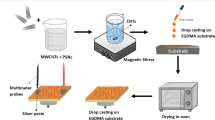Abstract
Polymer composites using carbon nanotubes (CNTs) are fast growing class of materials since CNTs exhibit a high aspect ratio, unique electrical, mechanical and structural properties which contribute to novel characteristics for engineering applications such as actuators, hydrogen storage, chemical sensors and nanoelectronic devices. Several papers have been published utilizing CNTs as the sensing material in pressure, flow, thermal, gas, optical, mass, strain, stress, chemical and biological sensors. Amongst many of its superior electro-mechanical properties, piezoresistive effect in CNTs is attractive for sensor design. When CNTs are subjected to a mechanical strain, a change in its chirality leads to modulation of its conductance. For this investigation, biocompatible polymer matrices prepared using PMMA and PCL were used to provide good interfacial bonding between VNTs. MWCNT mixed in 0.2, 0.5 and 1.0 % w/w content were used for the preparation of polymer nanocomposites. PMMA-based nanocomposites were prepared via the mixing of the MWCNT and polymer in a dichloromethane solution, while for the PCL-based nanocomposites as a solvent tetra-hyrofurane was used. Characterization of the nanocomposite films was performed by DSC, TGA, WAX, FTIR and SEM, as well as electrical measurements. Sensor activity was followed through the changes in the electrical conductivity of the nanocomposite films indicating that MWCNT into polymer matrix significantly changes their properties.
Access this chapter
Tax calculation will be finalised at checkout
Purchases are for personal use only
Similar content being viewed by others
References
Sinha N, Ma J, Yeow JT (2006) Carbon nanotube-based sensors. J Nanosci Nanotechnol 6:573–590
Fujiware A, Jshii K, Suematsu H, Kataura H, Maniwa Y, Suzuki S, Achiba Y (2001) Gas adsorption in the inside and outside of single-walled carbon nanotubes. Chem Phys Lett 336:205–211
Zahab A, Spina L, Poncharal P, Marliere C (2000) Water-vapor effect on the electrical conductivity of a single-walled carbon nanotube mat. Phys Rev B 62:10000–10003
Sumanasekera GU, Pradhan BK, Romero HE, Adu CKW, Foley HC, Eklund PC (2002) Thermoelectric chemical sensor based on single wall carbon nanotubes. Mol Cryst Liquid Cryst 387:31–37
Kang WP, Wong YM, Davidson JL, Wisitsora A, Soh KL (2003) A novel microelectronic gas sensor utilizing carbon nanotubes for hydrogen gas detection. Sens Actuators B 93:327–332
Dharap P, Li Z, Nagarajaiah S, Barrera EV (2004) Nanotube film based on single-wall carbon nanotubes for strain sensing. Nanotechnology 15:379–382
Shandas R, Lanning C (2003) Development and validation of implantable sensors for monitoring function of prosthetic heart valves: in vitro studies. Med Biol Eng Comput 41:416–424
Abraham JK, Philip B, Witchurch A, Varadan VK, Reddy CC (2004) A compact wireless gas sensor using a carbon nanotube/PMMA thin film chemiresistor. Smart Mater Struct 13:1045–1049
Santhanam KSV, Sangoi R, Fuller L (2005) A chemical sensor for chloromethanes using a nanocomposite of multiwalled carbon nanotubes with poly(3-methylthiophene). Sens Actuator B106:766–771
Wei C, Dai L, Roy A, Tolle TB (2006) Multifunctional chemical vapor sensors of aligned carbon nanotube and polymer composites. J Am Chem Soc 128:1412–1413
Li Y, Wang H, Cao X, Yuan M, Yang M (2008) A composite of polyelectrolyte-grafted multi-walled carbon nanotubes and in situ polymerized polyaniline for the detection of low concentration triethylamine vapor. Nanotechnology 19:015503. doi:10.1088/0957-4484/19/01/015503
Author information
Authors and Affiliations
Corresponding author
Editor information
Editors and Affiliations
Rights and permissions
Copyright information
© 2013 Springer Science+Business Media Dordrecht
About this paper
Cite this paper
Grozdanov, A., Tomova, A., Dimitrov, A. (2013). Polymer Nanocomposite Films as a Potential Sensor. In: Vaseashta, A., Khudaverdyan, S. (eds) Advanced Sensors for Safety and Security. NATO Science for Peace and Security Series B: Physics and Biophysics. Springer, Dordrecht. https://doi.org/10.1007/978-94-007-7003-4_12
Download citation
DOI: https://doi.org/10.1007/978-94-007-7003-4_12
Published:
Publisher Name: Springer, Dordrecht
Print ISBN: 978-94-007-7002-7
Online ISBN: 978-94-007-7003-4
eBook Packages: Physics and AstronomyPhysics and Astronomy (R0)




